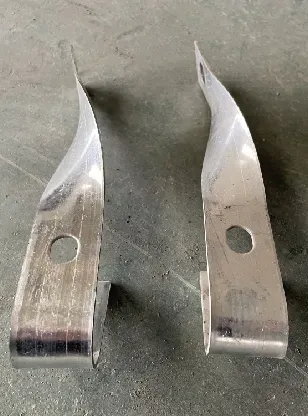loading...
- No. 9, Xingyuan South Street, Dongwaihuan Road, Zaoqiang County, Hengshui, Hebei, China
- admin@zjcomposites.com
- +86 15097380338
- Welcome to visit our website!
frp c channel
Understanding the FRP C Channel A Composite Solution
In the dynamic world of construction materials, fiber-reinforced polymer (FRP) has emerged as a standout choice, providing numerous benefits over traditional materials like steel and concrete. One specific form of FRP that has gained popularity is the FRP C channel. This article will explore the characteristics, advantages, applications, and challenges associated with FRP C channels in modern engineering.
What is an FRP C Channel?
An FRP C channel is a structural component that resembles the letter C, made from composite materials reinforced with fiberglass or other fibers. These channels are designed to bear loads and are commonly used in various construction and manufacturing projects. The FRP composite material offers strength and durability without the weight and corrosion issues associated with traditional steel channels.
Key Characteristics of FRP C Channels
1. Strength-to-Weight Ratio One of the most significant advantages of FRP C channels is their exceptional strength-to-weight ratio. These channels are lightweight yet incredibly strong, making them ideal for applications where reducing overall weight is critical.
2. Corrosion Resistance Unlike steel, FRP C channels are resistant to corrosion from chemicals, moisture, and environmental factors. This characteristic makes them suitable for use in harsh environments such as marine and chemical processing applications.
3. Flexibility in Design FRP materials can be easily molded into various shapes, providing architects and engineers with the flexibility to design innovative structures without the constraints posed by traditional materials.
4. Thermal Properties FRP is an electrical insulator, which can be beneficial in applications where electrical conductivity is a concern. Additionally, FRP C channels have good thermal insulation properties.
5. Durability and Longevity FRP C channels have a long service life due to their resistance to environmental degradation. This characteristic translates to reduced maintenance costs and enhanced life cycle performance for structures.
Applications of FRP C Channels
FRP C channels are employed in a variety of applications. Some notable uses include
frp c channel

1. Infrastructure In the construction of bridges, tunnels, and support structures, FRP C channels are used for their lightweight properties and resistance to corrosion.
2. Marine Industries These channels find extensive applications in the marine sector, such as in docks and shipbuilding, where they provide structural support without the risk of rusting.
3. Industrial Settings Many manufacturing facilities utilize FRP C channels in machinery, platforms, and storage solutions due to their strength and minimal weight, which enhances workplace safety.
4. Aerospace and Automotive Lightweight and durable, FRP C channels are often used in the aerospace and automotive industries, supporting components where reducing weight is critical for efficiency and performance.
Challenges of Using FRP C Channels
Despite their many advantages, the adoption of FRP C channels is not without challenges
1. Cost The initial cost of FRP materials can be higher than traditional options like steel. However, the long-term savings from reduced maintenance and increased lifespan can offset this initial investment.
2. Limited Repair Options Unlike steel, which can be welded or modified relatively easily, repairs on FRP components might require specialized techniques and materials, making them less convenient in some cases.
3. Market Awareness Some engineers and architects may still prefer traditional materials due to familiarity, leading to a slow adoption rate of innovative materials like FRP C channels.
Conclusion
FRP C channels represent a significant advancement in construction materials, combining strength, durability, and versatility with lightweight properties. They address many of the weaknesses associated with traditional building materials, particularly in environments where corrosion and weight are critical factors. As awareness and understanding of their benefits grow among engineers and designers, the potential for FRP C channels in modern construction and manufacturing continues to expand. Embracing these innovative solutions can contribute to more sustainable and efficient designs in various industries, paving the way for the future of construction materials.
-
GRP Structures: The Future of Lightweight, High-Performance EngineeringNewsJun.20,2025
-
FRP Water Tank: High-Performance Storage for Corrosive and Clean Water SystemsNewsJun.20,2025
-
FRP Square Tube: The New Industry Standard for Chemical and Structural ApplicationsNewsJun.20,2025
-
FRP Pultruded Profiles: The Ultimate Choice for Lightweight Structural StrengthNewsJun.20,2025
-
FRP Handrails: The Safer, Smarter, and Stronger Choice for Modern InfrastructureNewsJun.20,2025
-
FRP Grating: The Smart Solution for Durable, Lightweight Industrial FlooringNewsJun.20,2025
-
Why Choose a Galvanized Water Tank for Your Storage NeedsNewsMay.21,2025
